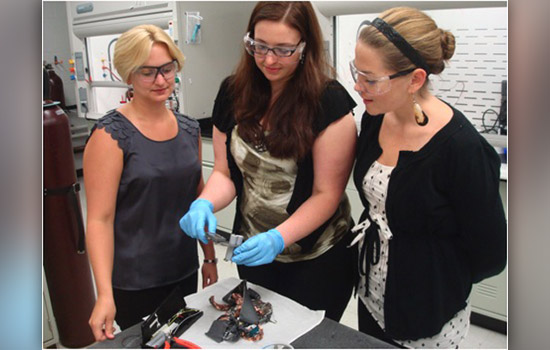Research Team Targets Reducing Impact from Battery Waste on the Environment
Multiple grants awarded to RIT’s Golisano Institute for Sustainability to support effort
Submitted
Golisano Institute for Sustainability assistant professor Gabrielle Gaustad, left, student Chelsea Bailey and assistant professor Callie Babbitt study the capabilities of recycling lithium-ion batteries.
As Americans replaced their laptop computers and mobile phones last year, it’s estimated that more than 300 million lithium-ion batteries used to power these devices entered the waste stream. That number will grow with the increasing use of personal electronics and the commercialization of renewable energy storage systems for electronic vehicles.
Managing this growing waste challenge while protecting the environment and creating jobs, particularly within New York state, is the challenge facing Gabrielle Gaustad and her colleagues at Rochester Institute of Technology’s Golisano Institute for Sustainability. The team is exploring that issue, supported by grants totaling more than $700,000 from national and state agencies.
“We have been quite fortunate to work with such forward-thinking funding groups on battery recycling, and I have personally been lucky to team up with such great collaborators here at RIT,” says Gaustad, RIT assistant professor and lead investigator for these grants.
Gaustad, joined by Callie Babbitt, assistant professor of sustainability, and Brian Landi, assistant professor of chemical engineering, launched this research with a 2010 grant from the New York State Energy Research and Development Authority to study economic viability of recycling and remanufacturing lithium-ion batteries. An additional $293,000 grant, awarded by the National Science Foundation this summer, will expand this research effort by quantifying environmental, health and safety tradeoffs of alternate recycling pathways, with particular focus on the fate of the nanomaterials that can be found in new battery technologies.
“Fundamental studies currently have mainly examined simple, homogeneous materials comprised of a single metal, metal oxide or a simple organic moiety,” states Barbara Karn, program director for the Environmental Health & Safety of Nanomaterials division of Chemical, Biological, Environmental and Transport Systems at NSF. “Nanomaterials in commerce have moved well beyond these simple, first generation materials. To date there has been little work that explicitly addresses the environmental implications of nano-scale materials in batteries, despite recognition of considerable environmental uncertainties and concern at end-of-life.”
A third grant awarded this summer of $150,000 from the New York State Pollution Prevention Institute will allow Gaustad and Babbitt to focus their investigation on environmentally benign battery recycling processes. This work will compare cost, performance and environmental impacts of bio-based leaching acids as compared to the harsh inorganic acids normally used in battery recycling.
“Process optimization for cost and performance alone is not enough,” says Anahita Williamson, director of the New York State Pollution Prevention Institute. “The focus of industrial process optimization has to include environmental impact as well. Developing a process that avoids the use of hazardous chemicals while maintaining or improving the performance of the process at an equivalent or lower overall cost would be a big step forward in the movement towards the increased use of lithium-ion batteries.”
These grants are part of the broader research and educational initiatives in the areas of sustainable production, energy and mobility systems carried out at the Golisano Institute for Sustainability.
“Research and training opportunities provided by these grants will enhance the educational experience for our Ph.D. and M.S. students,” explains Babbitt. “Our unique graduate programs prepare students for the green economy workforce by combining depth through technology-driven research with breadth of understanding the systems-level sustainability implications of these technologies.”














